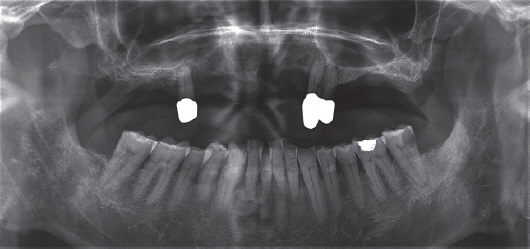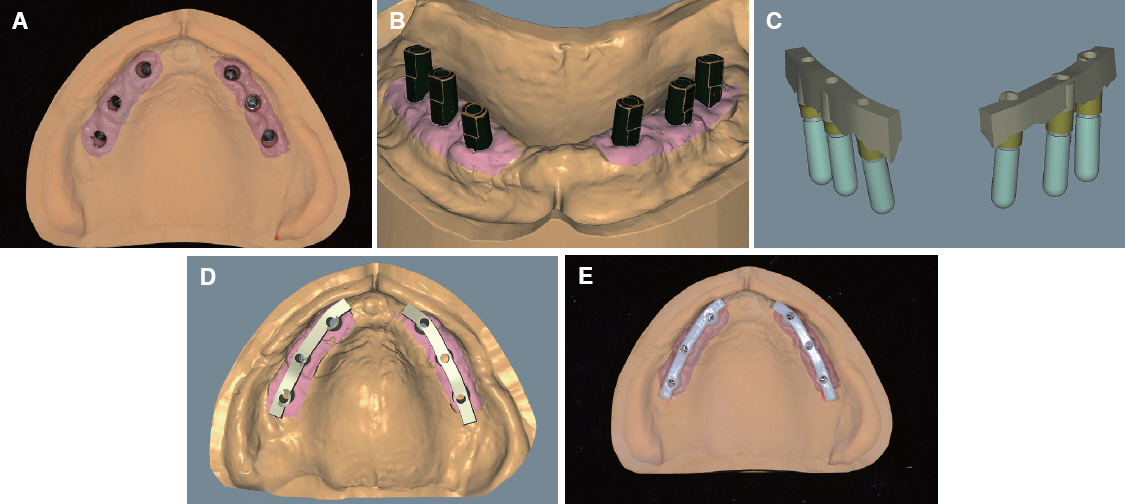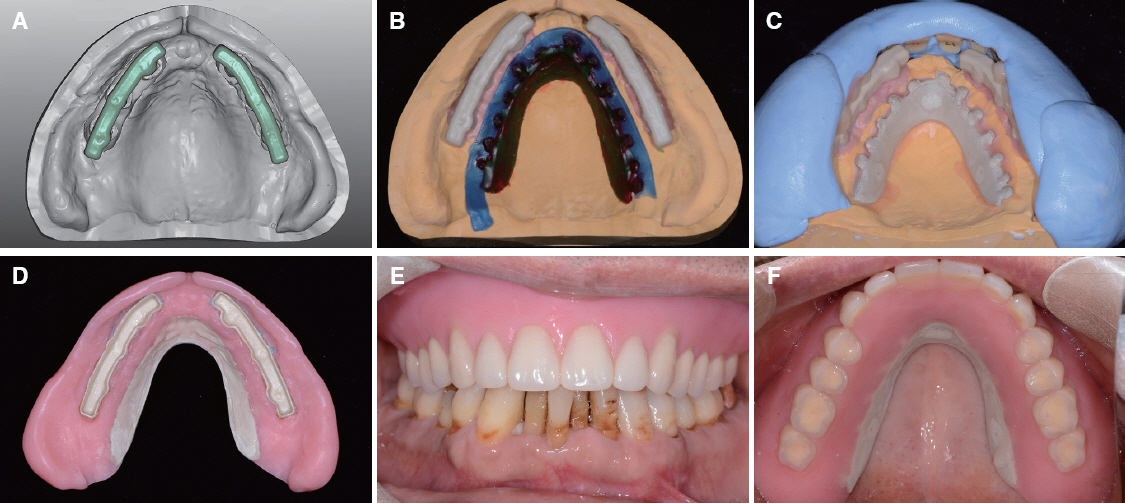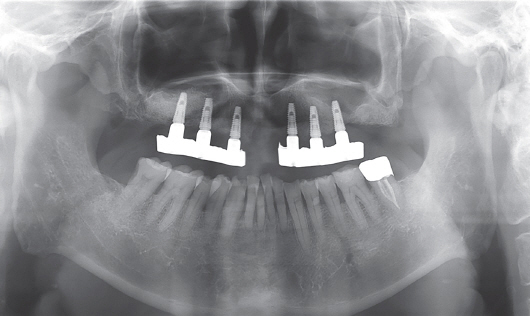J Dent Rehabil Appl Sci.
2017 Dec;33(4):307-313. 10.14368/jdras.2017.33.4.307.
Maxillar implant-retained overdenture using CAD/CAM milled zirconia bar with PEKK sleeve: a case report
- Affiliations
-
- 1Department of Prosthodontics, School of Dentistry, Kyungpook National University, Daegu, Republic of Korea. chlee@knu.ac.kr
- KMID: 2405544
- DOI: http://doi.org/10.14368/jdras.2017.33.4.307
Abstract
- The object of this case report is to introduce milled zirconia bar and PEKK female part made by CAD/CAM technology for bar attachment implant supported overdenture in maxillary edentulous patients. For over 2 years, in terms of function and esthetics, satisfactory result was obtained. Esthetically and functionally satisfactory results were obtained in periodic follow up check.
Figure
Reference
-
References
1. Zitzmann NU, Marinello CP. Treatment plan for restoring the edentulous maxilla with implantsupported restorations: removable overdenture versus fixed partial denture design. J Prosthet Dent. 1999; 82:188–96. DOI: 10.1016/S0022-3913(99)70155-1.2. Zembic A, Wismeijer D. Patient-reported outcomes of maxillary implant-supported overdentures compared with conventional dentures. Clin Oral Implants Res. 2014; 25:441–50. DOI: 10.1111/clr.12169. PMID: 23581398.3. Sanna A, Nuytens P, Naert I, Quirynen M. Successful outcome of splinted implants supporting a 'planned'maxillary overdenture: a retrospective evaluation and comparison with fixed full dental restoration. Clin Oral Implants Res. 2009; 20:406–13. DOI: 10.1111/j.1600-0501.2008.01664.x. PMID: 19298295.4. Sadowsky SJ, Zitzmann NU. Protocols for the maxillary implant overdenture: a systematic review. Int J Oral Maxillofac Implants. 2016; 31(Suppl):s182–91. DOI: 10.11607/jomi.16suppl.g5.2. PMID: 27228249.5. Kim HY, Lee JY, Shin SW, Bryant SR. Attachment systems for mandibular implant overdentures: a systematic review. J Adv Prosthodont. 2012; 4:197203. DOI: 10.4047/jap.2012.4.4.197. PMID: 23236571. PMCID: PMC3517957.6. Stoumpis C, Kohal RJ. To splint or not to splint oral implants in the implant-supported overdenture therapy? A systematic literature review. J Oral Rehabil. 2011; 38:857–69. DOI: 10.1111/j.1365-2842.2011.02220.x. PMID: 21480943.7. Murray MD, Darvell BW. The evolution of the complete denture base. Theories of complete denture retention - a review. Part 1. Aust Dent J. 1993; 38:216–9. DOI: 10.1111/j.1834-7819.1993.tb03067.x. PMID: 8373295.8. Petropoulos VC, Smith W, Kousvelari E. Comparison of retention and release periods for implant overdenture attachments. Int J Oral Maxillofac Implants. 1997; 12:176–85. PMID: 9109267.9. Sadowsky SJ. Treatment considerations for maxillary implant overdentures: a systematic review. J Prosthet Dent. 2007; 97:340–8. DOI: 10.1016/S0022-3913(07)60022-5.10. van Kampen F, Cune M, van der Bilt A, Bosman F. Retention and postinsertion maintenance of barclip, ball and magnet attachments in mandibular implant overdenture treatment: an in vivo comparison after 3 months of function. Clin Oral Implants Res. 2003; 14:720–6. DOI: 10.1046/j.0905-7161.2003.00961.x. PMID: 15015948.11. Mericske-Stern RD, Taylor TD, Belser U. Management of the edentulous patient. Clin Oral Implants Res. 2000; 11:108–25. DOI: 10.1034/j.1600-0501.2000.011S1108.x. PMID: 11168261.12. Katsoulis J, Mericske-Stern R, Yates DM, Izutani N, Enkling N, Blatz MB. In vitro precision of fit of computer-aided design and computer-aided manufacturing titanium and zirconium dioxide bars. Dent Mater. 2013; 29:945–53. DOI: 10.1016/j.dental.2013.07.004. PMID: 23890960.13. Najeeb S, Zafar MS, Khurshid Z, Siddiqui F. Applications of polyetheretherketone (PEEK) in oral implantology and prosthodontics. J Prosthodont Res. 2016; 60:12–9. DOI: 10.1016/j.jpor.2015.10.001. PMID: 26520679.14. Park C, Jun DJ, Park SW, Lim HP. Use of polyaryletherketone (PAEK) based polymer for implantsupported telescopic overdenture: a case report. J Adv Prosthodont. 2017; 9:74–6. DOI: 10.4047/jap.2017.9.1.74. PMID: 28243395. PMCID: PMC5321592.15. Passia N, Ghazal M, Kern M. Long-term retention behaviour of resin matrix attachment systems for overdentures. J Mech Behav Biomed Mater. 2016; 57:88–94. DOI: 10.1016/j.jmbbm.2015.11.038. PMID: 26705935.
- Full Text Links
- Actions
-
Cited
- CITED
-
- Close
- Share
- Similar articles
-
- Rehabilitation of edentulous maxilla with implant-supported milled bar overdenture using CAD/CAM customized abutment: A case report
- Detachable zirconia prosthesis using Milled bar and ADDTOC attachment in partial edentulous mandible: A case report
- Rehabilitation using mandibular implant overdenture with CAD/CAM milled bar: A case report
- CAD-CAM fabricated Milled-bar and Implant Overdenture after Reconstruction with a Fibular Free Flap: A Clinical Report
- Implant-supported milled bar overdenture with two implant surgical guides








